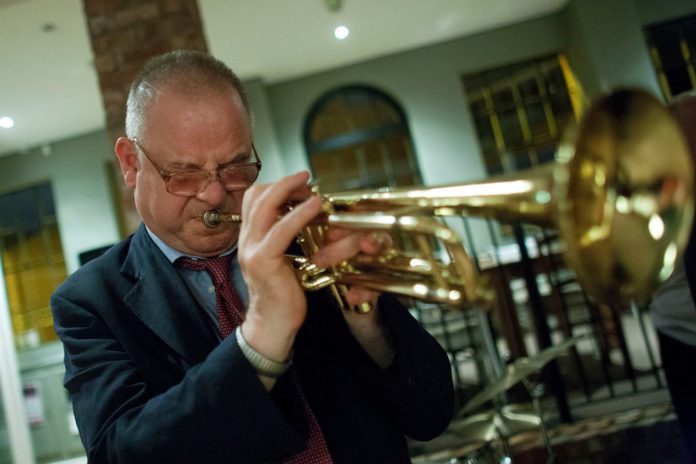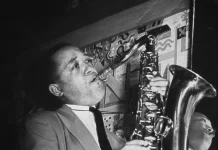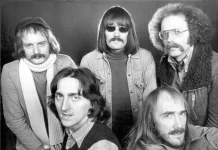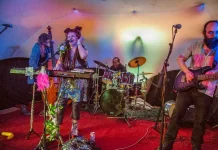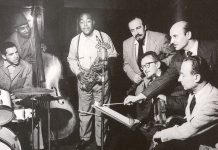I had John McLaughlin and YouTube to thank at the end of 2020 – the first “annus horribilis” of the pandemic – for drawing my attention to the Jazz Foundation of America’s Covid-19 Fund. Since I wrote about jazz on YouTube in a print issue of Jazz Journal, back in some Gutenberg Mesozoic, the numbers of film clips about jazz on the site and the viewers accessing them seem to have increased a trillionfold. There are connections.
Almost a year ago, McLaughlin uploaded a video featuring him and the other three members of his 4th Dimension band – drummer Ranjit Barot, pianist (and drummer) Gary Husband, and bassist Etienne M’Bappe – playing Lockdown Blues, in one of those multi-image broadcasts of musicians in their studies or front rooms. (McLaughlin’s was extra-commodious with some tasteful brickwork, as befitted a guitarist whose instrument tends towards the space-fillingly expansive; Husband’s was in a comfy little enclosure with a table lamp; Barot’s looked like an equally tightish place where he could bash away at a safe distance; and M’Bappe’s was – well, a corner where he could look as cool as he does on stage).
A sun-burned and leonine McLaughlin introduced the DIY gig, which he coupled with an appeal to donate to the fund. (That McLaughlin is a British musician and that his call was for a response to an American appeal simply illustrated how jazz’s internationalism sets the compass points spinning out of control). The long-established 4th Dimension, he said, was a family, but it was addressing the bigger family of humanity.
One of the JFA’s aims is to help musicians at crisis point. Even in non-pandemic times, this largesse is being spread across an ever-widening community, as musicians grow old or become ill and rely on the Foundation and anything similar for day-to-day sustenance. Pandemic-type phenomena (i.e., nasty things coming out of the night), just added to the routine woes of unsung musicians in New Orleans when they took the form of Hurricane Katrina. Jazz musicians everywhere live often on the edge, with little job security and access to only sparse personal savings. The Covid-19 Musicians Emergency Fund was set up to help a new and unexpected surge of those needing aid for themselves and their families, as they faced hardship. Clubs have closed and festivals been cancelled. It’s been grim. As we all know.
I write about McLaughlin’s video in the past tense, but it’s still viewable – when I last looked it had been seen by almost 8,000. It’s a bonus in terms of the immortality of items on the Internet. The pandemic is by definition worldwide. As long ago as last September, Westminster’s All Party Parliamentary Jazz Appreciation Group (APPG) published a paper by its secretariat, Chris Hodgkins (in which role he’s assisted by Louis Flood, Ali Bland, and Aoife Forbes), reinforcing the findings of the Digital Culture, Media and Sport select committee on the impact of Covid in the areas it was responsible for. It highlighted inadequate funding and the difficulties experienced by self-employed jazz musicians and promoters in accessing financial help. The APPG, backed by Hodgkins’s impressive and detailed research, continues to lobby for jazz and its musicians, especially where the pandemic has seriously impacted on their lives (www.appjag.org).
But it would take more than a rampaging virus to shut down jazz altogether. Musicians are brick-built. Despite Covid’s knockout blows, there’s been a mass rising from the canvas, and musicians have been shaken but stirred to resumption of activities in some form or another; although one musician told me that if you relied on playing for a TV advert for Curly-Wurlys it was likely that that too may have dried up. The annual APPG awards went ahead this year, acknowledging the difficulties by introducing a new category for lockdown innovation. Pianist Liam Noble won with his Sunday Lockdown Live sessions, though the other three nominees – Joe Stilgoe, Adrian Cox and the Globe, Newcastle – tended to obscure numerically other innovators who didn’t make the cut or perhaps for some reason were not nominated.
I can’t help reflecting, though, that Lockdown Blues is a universe away from the ragged-arsed Delta blues musicians of yesteryear, hauling themselves from one venue to another and barely able to regard music as their main source of income. Without them and others like them, there may not have been jazz, or a jazz tradition to defend against the ravages of pestilence. The blues is two things: a cry from the depths and a 12-bar musical sequence [or 8½ or 16 or whatever they chose – ed]. It’s possible to play the latter while occupying a penthouse in Manhattan, way above the pandemic of poverty. But only a fool would insist on poverty as a condition of the authentic. Pandemics are to be ended, not perpetuated.
While the lifting of lockdown and other restrictions may give the appearance of a new normal (when what we want is the old one back), there may be hidden damage, not least to jazz musicians. Perhaps the most telling will be the torpor which Covid has induced in many of us, particularly that associated with having to stay indoors, not just to avoid infection but because there’s nothing going on for which we’d normally lever ourselves out of the armchair to attend. When festivals and club events return, will we have the inclination to support them?
This may be an acute problem for the nation’s jazz clubs. If, within reason, every paid-up club member of every club turned out for every gig, clubs would be better off anyway. It doesn’t always happen. It’s not because of apathy – well, partly it is – but because members think their support ends with paying their annual subs. There’s nothing worse for a musician than playing for an audience with numbers bordering on fewer than there are in the band.
Two jazz festivals near me in the Black Mountains, as well as triumphing over lockdown, may, like other events of their kind, turn access to jazz performances via streaming into a permanent medium. Last year, both the Brecon and Black Mountain Jazz’s Wall2Wall offered streamed paid-for music, the first provided by monster French online streaming company Vialma and the second by 47 Studios & Productions of Abergavenny. Last year BMJ filmed festival acts at its club and paid them a “live” performance fee; this year, acts have been filmed in the same way but the musicians stayed around to perform ticketed gigs in the evening before a restricted audience at a countryside venue. Filmed gigs will be streamed at the festival proper in October.
Vialma is a subscription service catering for wide tastes in music, not just jazz. It’s like YouTube, but you pay for it. You are also paying for tailored, high-definition sound and recording, which YouTube, dependent on the quality of uploads by divers hands, cannot always provide or guarantee. YouTube’s advantage is its historical reach: the ability to trawl immense amounts of televised, cinematic and other material since the time when a fertilised ovum was about to become John Logie Baird.
Why will streaming jazz become permanent? Because it’s music for the TV generations, which don’t mind self-imposed “lockdowns” and which are already downloading cataracts of music for listening. Streaming companies, too, will be obliged to provide extensive catalogues of what they are offering. Battle has commenced. Interesting times.
Jazz on YouTube continues to arrive with pandemical speed but wholly beneficial consequences. My pamphlet of linked stories, A Gloucester Trilogy (Templar Fiction) includes one which considers that in-between time when celebrities were dying and movie film was in its infancy.
There is, for example, no known footage of DH Lawrence, though photographs of him abound. Dylan Thomas may or may not have been filmed in the background on Pendine Sands in West Wales as an extra in a Hollywood film; the sequence is brief, part of a home movie, and identification difficult. But that’s it.
I now seek on YouTube film of any jazz musician I’ve never seen moving. The latest was French saxophonist Barney Wilen, a tenorman I admire enormously (US musicians did too) and who died aged 59 in Paris in 1996. I found a few clips of him, notably a French TV jazz programme broadcast from the Club St Germain, in which he appears alongside Clark Terry, Kenny Clarke, Pierre Michelot, and – Bud Powell. I then wondered if there was any more lengthy footage of Powell that caught him in his prime. After coming across an hour-long French TV documentary called Inner Exile, and Jørgen Leth’s 12-minute lyrical Stopforbud, I realised that it was late Powell and that if anyone would accord him the honour of a tribute while he still lived – precariously – it would be the French. The soundtrack of Powell playing is, however, worth the search for visuals. Even in decline he was sometimes matchless, like a torch sparked by an otherwise dying battery into momentary super-brightness.

